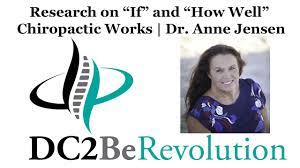An Interview with Dr. Anne Jensen
When I was a chiropractic student, I interviewed one hundred chiropractors for the DC2Be Revolution YouTube channel and podcast. This article is about the insights I gained from Dr. Jensen who got her Ph.D. from Oxford and has published a lot of research articles.
- Transition from a clinician to a researcher.
I was noticing patients were coming in with complaints and I was giving good adjustments and they were leaving better, but then six months later they come back in with the same complaints. I felt like I wasn’t getting ahead, and I didn’t know why. So, I started doing research in practice to understand more. I started designing little studies and doing data collecting in practice. I found out I was doing poor quality research. As a result, it was really hard to publish what I had done. I thought if I’m going to be serious about this I needed to go back to school. I started looking around to see who was doing good clinical research and it was Oxford in the UK. I applied and ten years later I had a Master’s and Ph.D.
- It’s hard to be a chiropractor in a prestigious research program.
I was the only chiropractor in the program and the only alternative health care professional in my PhD program. Most of them were psychologists and social workers. I was not only doing something that was off the beaten track for clinical medicine, I was also doing something off to being track for Chiropractic. When I was doing my very first presentation in my department in my first year at Oxford and demonstrating that in front of about 30 people.
Some of my cohort, PhD students and some medical researchers were watching as I was demonstrating and a supervisor stood up and said “this has not been proven, this is not scientifically validated.” They were right, but instead of writing it off as pseudo-science they said, let’s see if there is validity to this. That person became my supervisor and at graduation she told me that she didn’t think this was going to work so she wanted to be there when that happened, but to everyone’s surprise it did work.
I was heckled, harassed, and ignored most of the time I was at Oxford for the better part of 10 years. It was only in the last couple years that people started to pay attention. We got some very exciting results in my first study. They didn’t believe me so they had me replicate it. The replication study and then three or four studies after that supported the findings of the original study. Now we have six studies which are in the process of being published.
- The profession needs more research.
For most of my pre-Oxford life when I would talk about doing research I was told to do a case study or case series. If you look at the pyramid of evidence a case study is at the bottom. It’s a qualitative study, which is not considered good evidence. I would not recommend doing a case study. Take the plunge and do a small trial instead. It doesn’t really take that much more effort in the data collecting and, in the writing, up in the analysis.
Another thing, in ten years at Oxford I was only asked once how chiropractic works. In my department no one cares, they wanted to know if it worked, how well it worked, and does it cause harm. That’s the job of a clinical researcher. You need to figure out if it works, how well it works, and if it causes harm.
We have spent a lot of time and resources figuring out how Chiropractic works. The policymakers and the funders they don’t want to know how something works. They want to know if it works and how well it works. Why don’t we shift our funding to randomized trials instead of brain scans? We need to do more trials and then once we get a series of trials, we can then do a systematic review, which is right at the top of the pyramid. Systematic review and meta-analysis are the top. That is how we can change the conversation about chiropractic evidence.
To watch the entire interview, you can go here. https://www.youtube.com/watch?v=Y1mI3RwfKrI
Noah Volz, DC is the author the The Master Student: Book 1: Mindset: The Ultimate Guide to Success, Enjoyment and Productivity as a Chiropractic College Student.

